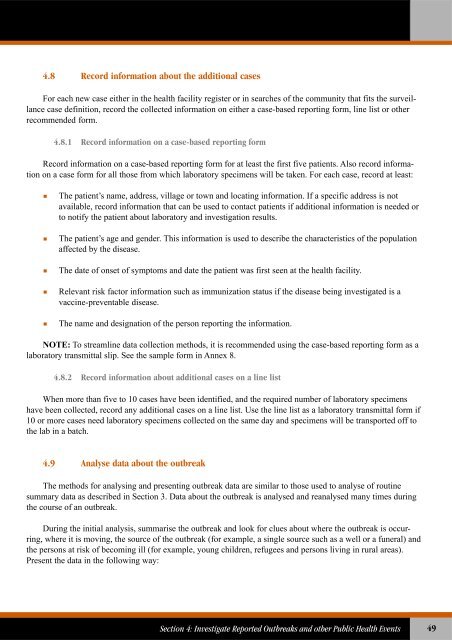Technical Guidelines for Integrated Disease Surveillance ... - PHRplus
Technical Guidelines for Integrated Disease Surveillance ... - PHRplus
Technical Guidelines for Integrated Disease Surveillance ... - PHRplus
You also want an ePaper? Increase the reach of your titles
YUMPU automatically turns print PDFs into web optimized ePapers that Google loves.
4.8 Record in<strong>for</strong>mation about the additional casesFor each new case either in the health facility register or in searches of the community that fits the surveillancecase definition, record the collected in<strong>for</strong>mation on either a case-based reporting <strong>for</strong>m, line list or otherrecommended <strong>for</strong>m.4.8.1 Record in<strong>for</strong>mation on a case-based reporting <strong>for</strong>mRecord in<strong>for</strong>mation on a case-based reporting <strong>for</strong>m <strong>for</strong> at least the first five patients. Also record in<strong>for</strong>mationon a case <strong>for</strong>m <strong>for</strong> all those from which laboratory specimens will be taken. For each case, record at least:The patient’s name, address, village or town and locating in<strong>for</strong>mation. If a specific address is notavailable, record in<strong>for</strong>mation that can be used to contact patients if additional in<strong>for</strong>mation is needed orto notify the patient about laboratory and investigation results.The patient’s age and gender. This in<strong>for</strong>mation is used to describe the characteristics of the populationaffected by the disease.The date of onset of symptoms and date the patient was first seen at the health facility.Relevant risk factor in<strong>for</strong>mation such as immunization status if the disease being investigated is avaccine-preventable disease.The name and designation of the person reporting the in<strong>for</strong>mation.NOTE: To streamline data collection methods, it is recommended using the case-based reporting <strong>for</strong>m as alaboratory transmittal slip. See the sample <strong>for</strong>m in Annex 8.4.8.2 Record in<strong>for</strong>mation about additional cases on a line listWhen more than five to 10 cases have been identified, and the required number of laboratory specimenshave been collected, record any additional cases on a line list. Use the line list as a laboratory transmittal <strong>for</strong>m if10 or more cases need laboratory specimens collected on the same day and specimens will be transported off tothe lab in a batch.4.9 Analyse data about the outbreakThe methods <strong>for</strong> analysing and presenting outbreak data are similar to those used to analyse of routinesummary data as described in Section 3. Data about the outbreak is analysed and reanalysed many times duringthe course of an outbreak.During the initial analysis, summarise the outbreak and look <strong>for</strong> clues about where the outbreak is occurring,where it is moving, the source of the outbreak (<strong>for</strong> example, a single source such as a well or a funeral) andthe persons at risk of becoming ill (<strong>for</strong> example, young children, refugees and persons living in rural areas).Present the data in the following way:Section 4: Investigate Reported Outbreaks and other Public Health Events49















